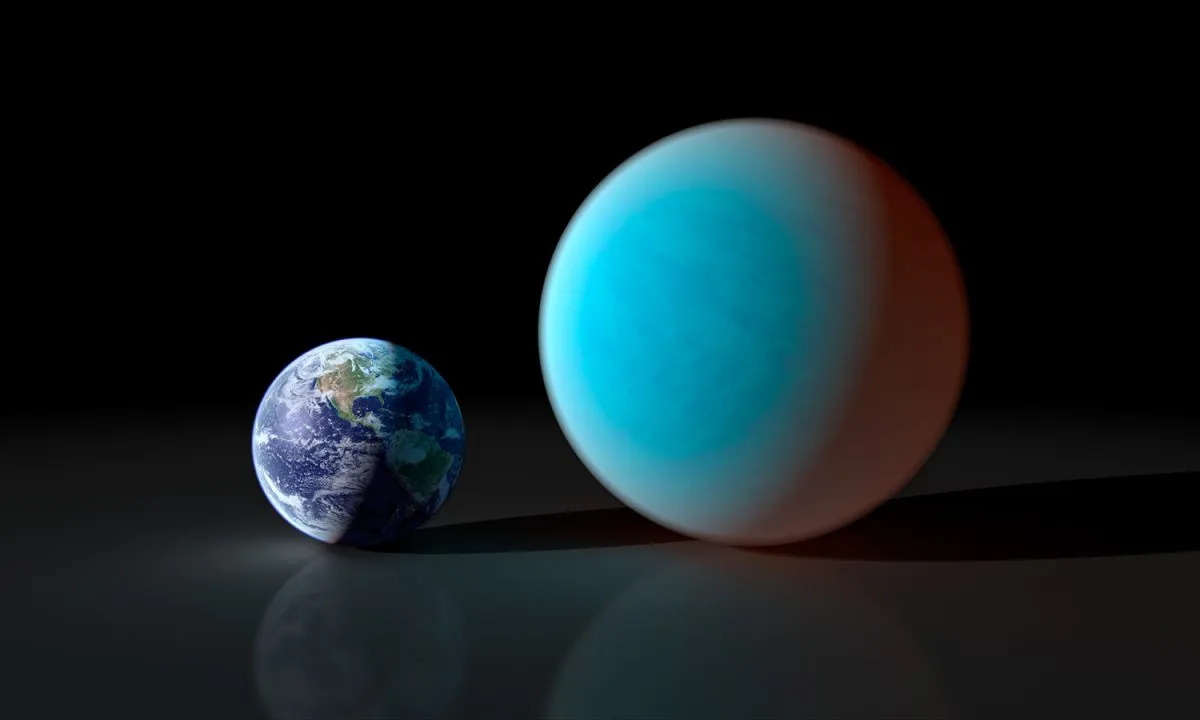The James Webb Space Telescope has discovered evidence of an atmosphere around a rocky super-Earth exoplanet named 55 Cancri e.
The planet lies just 41 lightyears from Earth and is one of five confirmed worlds orbiting a Sun-like star known as 55 Cancri A in the constellation Cancer.
The discovery is the best evidence yet for an atmosphere surrounding a planet beyond our Solar System, and could be a major breakthrough in the search for habitable planets elsewhere in the Galaxy.

Key facts about 55 Cancri e
A team of astronomers used the James Webb Space Telescope to make the discovery.
A key point is that the discovery shows a rocky exoplanet being blasted with scorching temperatures and radiation from its host star can still sustain a gaseous atmosphere.
55 Cancri e is a super-Earth exoplanet, which means it's similar in composition to the rocky planets of our Solar System.
However, it's nearly twice as wide as Earth and has a slightly greater density.
The planet also orbits so close to its star, its surface is likely a deep ocean of molten magma.
55 Cancri e takes just 18 hours to orbit the star; extremely short when compared to Earth's 365-day orbit.

And the exoplanet is likely tidally locked, the same side always facing the host star in the same way the same side of our Moon always faces Earth.
This would mean one side of the planet was perpetually in darkness, while the other is constantly being bombarded by heat and radiation from the host star.
"55 Cancri e is one of the most enigmatic exoplanets," says Brice-Olivier Demory from the Center for Space and Habitability CSH of the University of Bern.
Demory is co-author of the study, which was published in Nature.
"Despite enormous amounts of observing time obtained with a dozen of ground and space facilities in the past decade, its very nature has remained elusive, until today, when parts of the puzzle could finally be put together thanks to the James Webb Space Telescope."

How the discovery was made
The James Webb Space Telescope measured changes in starlight as 55 Cancri e orbited its star
Webb's NIRCam (Near-Infrared Camera) and MIRI (Mid-Infrared Instrument) captured infrared light coming from the exoplanet.
The team measured the brightness of the star when 55 Cancri e was behind it, then the brightness of the star and planet combined.
Comparing the two enabled them to calculate the amount of infrared light coming from the dayside of the planet.

55 Cancri e's thermal emission (heat energy in the form of infrared light) indicates the planet could have an atmosphere.
If the planet were covered in dark molten rock and had a thin atmosphere or none at all, the temperature would be about 2,200°C (3,990°F).
"Instead, the MIRI data showed a relatively low temperature of about 1,500°C (2,730°F) Celsius," says Renyu Hu from NASA’s Jet Propulsion Laboratory, who led the team behind the study.
"This is a very strong indication that energy is being distributed from the dayside to the nightside, most likely by a volatile-rich atmosphere."
Further evidence of the atmosphere is the fact that Cancri 55 e's dayside is several hundred degrees cooler than it should be.
This points to infrared light from the surface being absorbed by an atmosphere on its way to Webb's instruments.

Where is the atmosphere coming from?
Gases surrounding 55 Cancri e are generated in the exoplanet's interior, say the team.
Any primary atmosphere would be completely gone because of the heat and radiation emanating from the host star.
The detected atmosphere is likely a secondary atmosphere, replenished by a bubbling magma ocean of crystals, liquid rock and dissolved gas.
About the scientists
"As a Postdoc at MIT I led the discovery of the first transit of 55 Cancri e, and in 2016 my team published the first map of a rocky exoplanet, which was 55 Cancri e", says Demory, who has been studying 55 Cancri e since the beginning of his career.
Demory was invited on the research programme by Hu, who was one of his colleagues at the Massachusetts Institute of Technology (MIT).
Evidence of the atmosphere around 55 Cancri e was hinted at in that 2016 study.
For this new paper, Demory undertook an independent analysis of Webb's dataset.
"In the past two years the space telescope CHEOPS, which has been developed and built at the University of Bern, has been key in solving several questions that astrophysicists had about 55 Cancri e.
"Webb complemented this picture at infrared wavelengths in showing that the super-Earth 55 Cancri e might be surrounded by an atmosphere with a composition consistent with carbon monoxide or carbon dioxide."

What next?
55 Cancri e is too hot to be habitable, but this study shows it could provide astronomers with the opportunity to study rocky planets and how their interiors, surface and atmospheres are intertwined.
It could even provide insights into the rocky planets of our Solar System, Venus, Earth and Mars.
"Ultimately, we want to understand what conditions make it possible for a rocky planet to sustain a gas-rich atmosphere: the key ingredient for a habitable planet," says Hu.
A Secondary Atmosphere on the Rocky Exoplanet 55 Cnc e by Renyu Hu and al. is published in Nature. read it at www.nature.com/articles/s41586-024-07432-x

